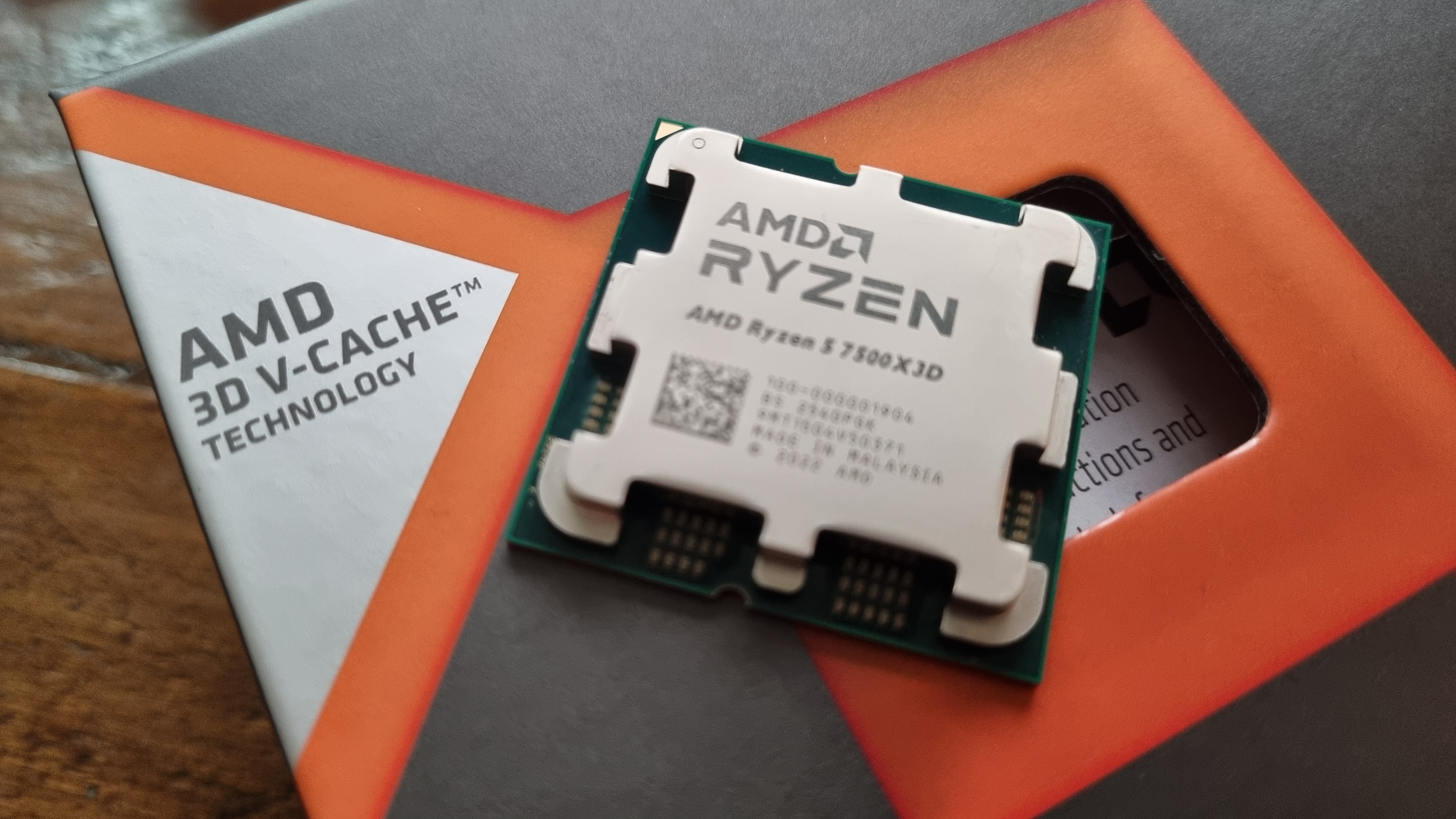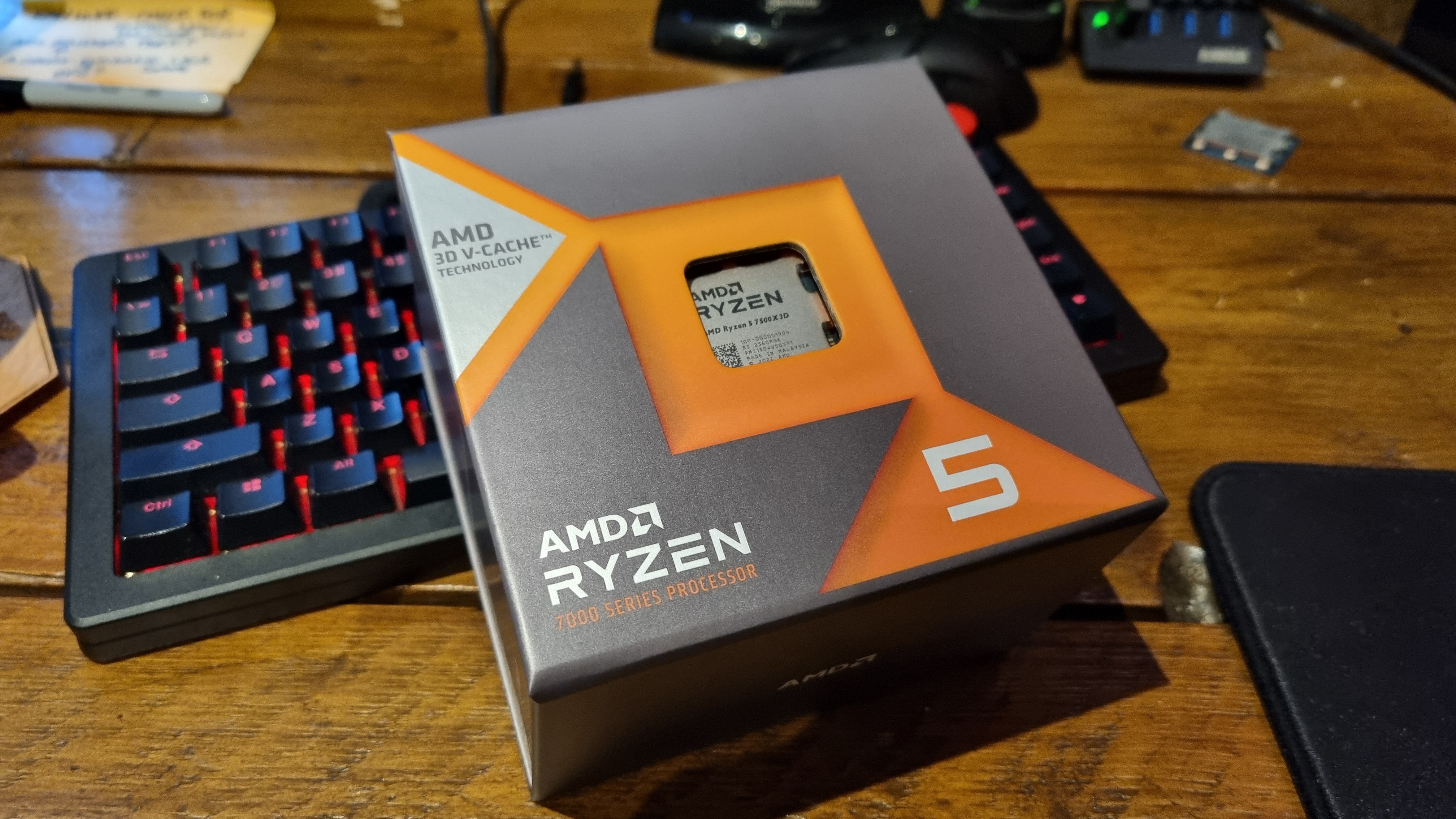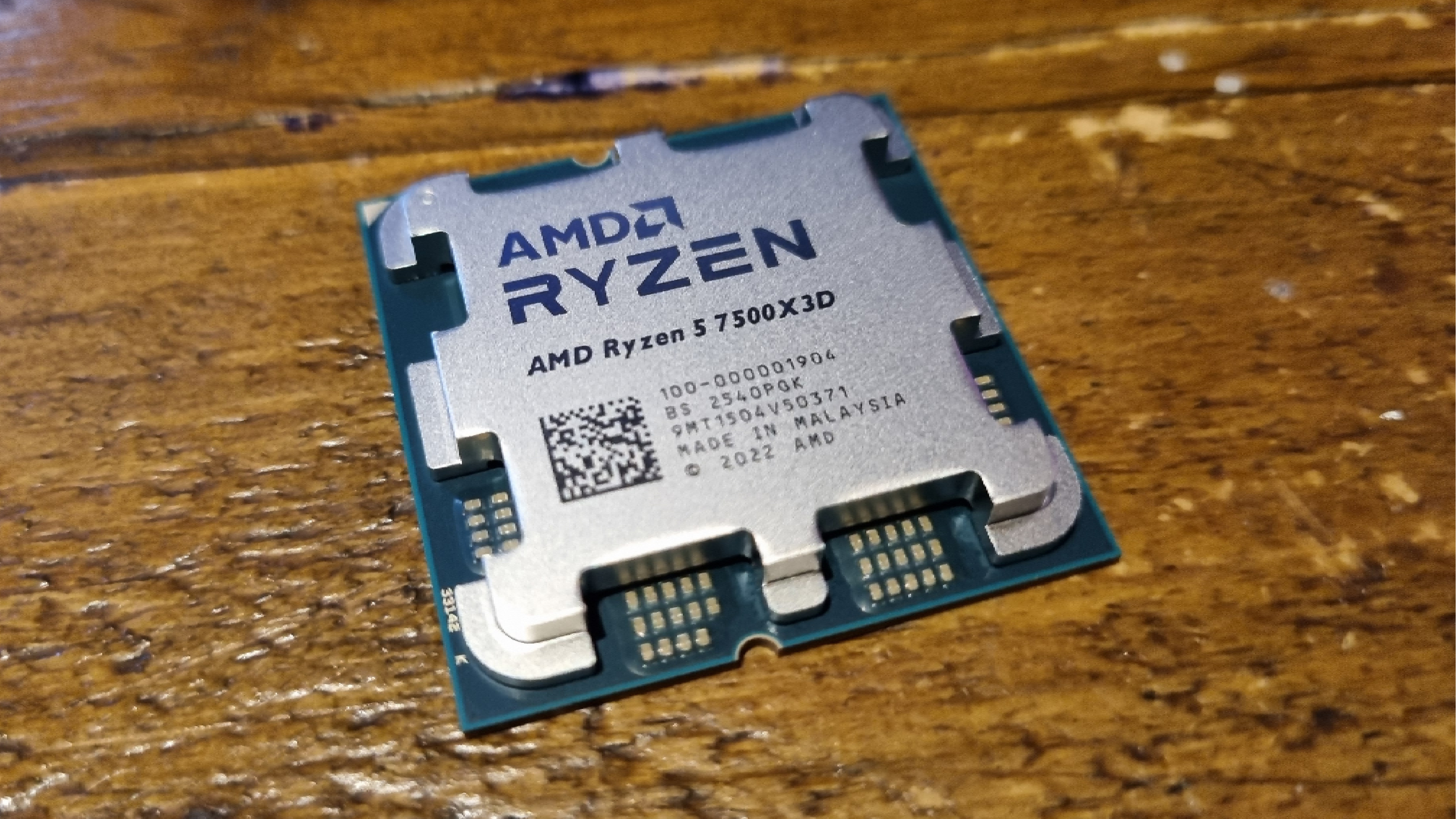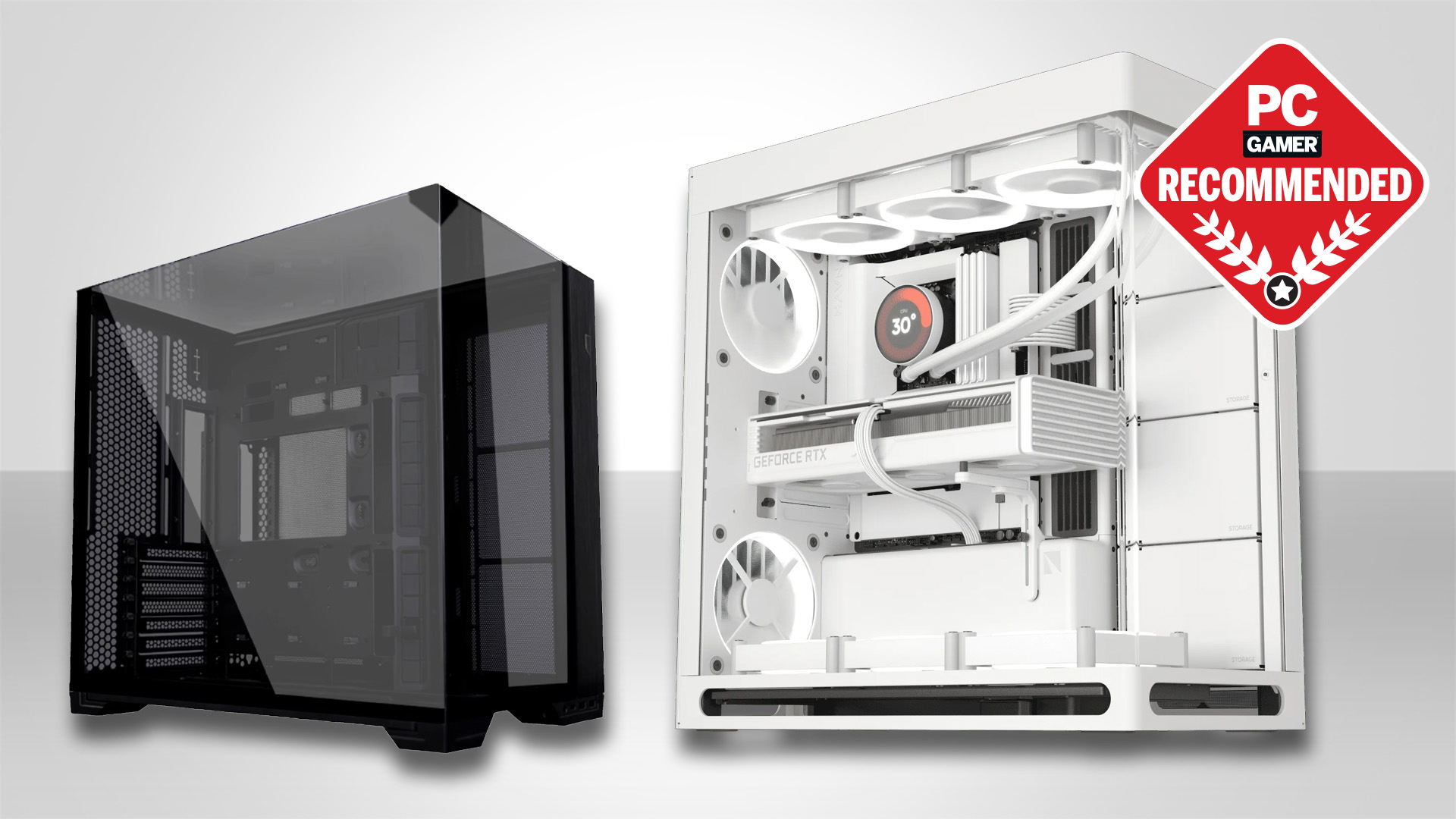Our Verdict
While $269 is enough cash to throw some doubt towards the title of "budget gaming CPU", the gaming performance the 7500X3D provides is meaty enough to make it a serious value proposition nonetheless. It's darn close to the more expensive (and now difficult to find) 7600X3D in the gaming benchmarks, and gives many non-X3D CPUs a real thrashing in the process.
For
- Excellent gaming performance
- Chilled out under load
- Sips power
Against
- Still pricey for a six-core chip
- Slightly off-the-pace productivity numbers
PC Gamer's got your back
When it comes to budget versions of the best gaming CPUs, we've been particularly big fans of the old AMD Ryzen 5 7600X. Those looking to save some money on a gaming processor are usually well-served by a fast-clocked six-core chip, and AMD's reasonably-priced contender has, until now at least, fit the bill perfectly.
What it's missing, however, is a good dose of 3D V-Cache. This has been AMD's ace up its sleeve for a while now, a stacked layer of extra L3 cache that many games love to take advantage of. We've seen its effectiveness when implemented on some of our favourite AM4 gaming processors of old, and it's also turned up in a more recent Zen 4 chip, the Ryzen 5 7600X3D, and the Zen 5-based Ryzen 7 9800X3D, our pick as the best gaming CPU overall.
The trouble is, 3D V-Cache-equipped AM5 chips are usually quite pricey. Those looking for a properly sub-$300 beastie with AMD's game-crunching cache tech (the 7600X3D has an MSRP of $299, and usually retails for a lot higher than that) have traditionally had to make do with chips built for the previous-gen AM4 socket, like the Ryzen 5 5700X3D.
No longer, it seems. Enter, the Ryzen 5 7500X3D—a $269/£245 six-core, 12-thread AM5 chip that adds an extra 64 MB dose of 3D V-cache to its budget CPU formula. It's already a smart move on paper, smearing a hefty dollop of AMD's special sauce on an otherwise fairly low-clocked chip in the hopes that it will provide a serious chunk of gaming performance—while still being affordable enough to tempt gamers on a budget looking to make the leap to AM5.
AMD Ryzen 5 7500X3D verdict



✅ You want excellent gaming performance for reasonable cash: The 7500X3D proves once more that 3D V-Cache is the secret sauce for great CPU performance in many games, and this is as cheap as you'll find it for on an AM5 chip.
❌ You're on a tight budget: While this little chip is very attractively priced for such a good performer, it's still not mega cheap. You could make do with a non 3D-cached CPU and put the money towards a better GPU instead for a potentially faster gaming rig overall.
The good news is, AMD's 3D V-Cache play has worked. While the 7500X3D is still a touch behind the 7600X3D in most of my gaming benchmarks, once price has been factored into the equation, the former makes for a more compelling affordable gaming CPU. The difference in frame rate figures really is minimal between the two in most cases.
And as for the regular 7600X? The 7500X3D gives it a pretty thorough pasting in the gaming benchmarks. In fact, it comes close to nudging the Ryzen 7 7800X3D at points, which was our best gaming CPU pick of the previous generation.
Plus, although you'll only technically save $30 compared to the 7600X3D, that particular chip can be very difficult to find for anywhere near its MSRP right now—and if cash is a concern, you'd be better off putting those extra funds towards a better GPU, small as that contribution may be. A more powerful graphics card is where you'll really see the difference in terms of frame rates in most modern games, so that'd be my thinking if I was putting together a reasonably-priced gaming rig in 2025.
Keep up to date with the most important stories and the best deals, as picked by the PC Gamer team.
In the productivity stakes, however, the 7500X3D provides slightly more of a mixed bag. It sits a few points behind its rivals in most of our test suite, although it's far from a bad performance overall. Still, it must be said that if productivity and rendering speeds are your main concern, something with more cores and higher clocks from the current or previous gen of both AMD and Intel CPUs would perhaps be more suitable if you're looking for more of an all-rounder.
The 7500X3D also likes to run cool, and sips at its 65 W TDP allocation in very much the same way as the 7600X3D. That makes it an excellent choice for reasonably-priced small form factor builds, as this power-limited behaviour results in a chilled out little chip that barely makes a dent in the mighty 360 mm liquid cooler attached to my test machine.
This also bodes well for those of you looking to re-use an older cooling solution or smaller power supply, as both chips look to have had the reins pulled in when it comes to power and thermal figures.
Overall, it's a cool-running, power sipping, and relatively affordable CPU with enough juice to drive a genuinely performant gaming PC, with the only real downside being a small hit to productivity performance in favour of some serious real-world gaming grunt. While it's still pricey enough to stretch the margins of what could be considered a truly budget gaming CPU, it still gets you the gaming benefits of 3D V-Cache for a reasonable sum—and that makes it a compelling chip to build a modest-yet-mega AM5 rig around.
AMD Ryzen 5 7500X3D specs

| Row 0 - Cell 0 | Ryzen 5 7500X3D | Ryzen 5 7600X3D |
Cores/Threads | 6/12 | 6/12 |
Max boost freq. | 4.5 GHz | 4.7 GHz |
Base clock | 4.0 GHz | 4.1 GHz |
L2 cache | 6 MB | 6 MB |
L3 cache | 96 MB | 96 MB |
TDP | 65 W | 65 W |
TjMax | 95 °C | 89 °C |
Max memory speed (Non-OC) | DDR5-5200 | DDR5-5200 |
MSRP | $269/£245 | $299/£280 |
The Ryzen 7 7500X3D is a six-core, 12-thread Zen 4 CPU with a base clock speed of 4.0 GHz, with the capability to boost to 4.5 GHz under heavy load. In terms of architecture it looks virtually identical to the already-released Ryzen 7 7600X3D, except that particular chip can reach the somewhat-lofty heights of 4.7 GHz at top whack.
The six cores on offer here are built on TSMC's 5nm process, with the I/O die being built on 6 nm tech. The chip itself has 96 MB of L3 cache total, 64 MB of that being 3D V-Cache strapped to the CCD. It's here where we're going to see the major difference between this chip and many others in AMD and Intel's current lineup, as many games favour having as much L3 cache available as possible to store frequently accessed data, which means the CPU spends less time waiting for the memory to catch up in certain types of demanding tasks.
Mounting stacks of the stuff to a budget gaming chip should, in theory, result in good gaming performance overall without needing to rely on high clock speeds, which is why the 7500X3D's specs otherwise look a bit pedestrian on paper.
The maximum officially supported memory speed is DDR5-5200, but AMD says the sweet spot for performance is still DDR5-6000, as it allows the Infinity Fabric high speed interconnect system to clock to 2000 MHz with the memory and IMC running at a 3,000 MHz 1:1 ratio.
The active power management architecture and firmware has been brought in from the Ryzen 6000-series mobile processors, which will come into play later when we discuss the power draw benchmarks. The chip itself has a 65 W TGP, with a TjMax (the top thermal limit it'll push to before pulling itself back to prevent itself from overheating) being 95°C. It also uses AMD's Precision Boost 2 system to manage its clockspeeds, and the same RDNA 2 iGPU as the 7600X3D.
Okay, so it's not the most exciting specs sheet, I'll grant you. However, as we'll see in the benchmarks, the combination of a substantial whack of 3D V-Cache with a relatively chilled out, low clockspeed Zen 4 offering is still a potent one, particularly when it comes to gaming.
AMD Ryzen 5 7500X3D performance

Kicking things off with our gaming benchmarks suite, the little 7500X3D immediately gets to work proving exactly why 3D V-Cache makes a difference. Despite the 7600X having a significantly higher boost clock (5.4 GHz to the 7500X3D's 4.5 GHz), the older chip is soundly trounced in each of our gaming tests, often by a considerable margin.
In Baldur's Gate 3, for example, it equates to a stonking 33 fps difference. This game seems to love a dose of L3 cache, as the 7600X3D posts near-identical figures, with both the average and 1% low figures being a single frame ahead. That being said, the also-3D V-Cache-equipped 5700X3D was also put firmly in its place by both chips, suggesting that it's the combination of Zen 4 cores and lots of cache potential that add up to an impressive result.
The 7500X3D doesn't have it all its own way, though. While it's capable of racing neck and neck with the 7600X3D in most tests, it did have a brief but repeatable wobble in Homeworld 3, where its higher-clocked sibling managed to pull ahead by a whole 10 frames on average. Similarly, the 7500X3D falls slightly behind both the 7600X3D and 5700X3D in the Cyberpunk 2077 benchmark on average, although it managed to beat all our comparison CPUs in the 1% lows, with a remarkable 87 fps minimum result.
Speaking of remarkable gaming results, I'd like to mention the 7500X3D's average figures in comparison to the Ryzen 7 7800X3D. I haven't included our previous top gaming chip in the charts here, as it's a $400+ eight-core monster that wouldn't make for a fair comparison overall. However, it's worth mentioning that the baby AMD CPU is only two frames behind its monstrous, much more powerful older brother in BG3, 11 frames behind it in Cyberpunk 2077, and three whole frames ahead of it in Metro Exodus Enhanced on average.
Now, before we all go jumping up and down, I should point out that it's been a year or so since we last put the 7800X3D through its paces. Many game updates, BIOS upgrades, and microcode changes have come to pass since then, so it's not quite an apples-to-apples comparison. That being said, we were prepared to call the 7800X3D's performance superb back then, and I don't think it's much less so in 2025.
When it comes to productivity, the 7500X3D is slightly less impressive. While it's only just behind the pack in the benchmarks (which result in an impressively tight grouping between our comparison CPUs overall), it's still behind both the 7600X3D and 7600X in most tasks. That being said, it does manage to leap ahead of the 5700X3D in both single-core and multi-core Cinebench 2024 testing, although it's a touch behind both of the AM5 contenders under the same conditions.
As a result of that tight grouping, I'd say the 7500X3D isn't a bad chip for productivity tasks overall, despite being ever-so-slightly off the pace. Lagging the pack by single-digit points is far from a disappointing turn out for the little six-core chip, and if anything shows how relatively little is gained from the higher clock speeds of some of its rivals when it comes to rendering, compression, and file manipulation tasks.
Under gaming load, the CPU power draw test results in a 64 W average, a single watt below its TGP. Early on in my testing I was surprised to see that the peak power draw figures were remarkably close to its 65 W limit, as I couldn't push the chip to jump much beyond 68 W in brief moments even with Precision Boost Overdrive enabled.
Chatting to AMD, however, reveals that this is expected behaviour for this particular X3D chip, which seems determined to stay in its lane no matter the conditions, despite a reported 88 W potential in the chip info.
Thermal-wise, the 7500X3D also runs extremely cool, although the very low figures here are heavily contributed to by the massive 360 mm MSI AIO sitting in my test PC. It's overkill for this little chip, but the fact that the average thermals come in at a relatively ice-cold 52 °C under heavy gaming conditions (significantly under every other chip in our charts) speaks well of its tendency to keep itself chilled. Those looking to pair it with a smaller AIO (or a reasonably-sized air cooler) look to be well-served, if these figures are anything to go by.
PC Gamer test platform
Supplied by Cyberpower | MSI
Motherboard: MSI MPG X870E Edge Ti WiFi | RAM: Kingston Fury Beast RGB 32 GB (2 x 16 GB) @ 6000 MT/s | GPU: Nvidia GeForce RTX 4070 | Cooler: MAG CoreLiquid i360 White | SSD: Spatium M480 Pro 2 TB | PSU: MPG A1000GS PCIe 5 | Case: MAG Pano 100R White
AMD Ryzen 5 7500X3D analysis
The Ryzen 5 7500X3D is a storming little gaming CPU, and given that it's now the cheapest way to get a 3D V-Cache-equipped chip on the AM5 platform, it makes a compelling case for itself as one of the best, if not the best, budget gaming CPUs around.
The only thing giving me slight pause is the price. While the 7600X3D is difficult to find (and usually far too expensive if you do find a retailer listing), the 7500X3D certainly makes for a tempting offer at $269. However, part of me pulls back at the idea of calling a $250+ chip truly "budget", but perhaps "budget for a gaming superstar" is more than enough.
You could save a fair bit more by buying a 5700X3D on the AM4 platform, and still receive excellent gaming performance. That being said, while the AM4 socket has proven itself to last a lot longer than any of us would have thought, you would still be locking yourself into an older ecosystem (and DDR4 RAM) for a while to come. And given the performance on offer here, I'd say that the 7500X3D looks to be a CPU you could stick with for quite some time, all the while making the leap to a newer socket that's likely to stick around for a while yet itself.

As for the longevity of the chip itself, I'd say it's likely to be some time before six-core CPUs start struggling in demanding games, at least if they're speedy enough to begin with. The fact that the 7500X3D is capable of going toe-to-toe with our fastest gaming chip of the previous generation in some benchmarks suggests it'll be a CPU with plenty of grunt for a while to come, at least until eight-core chips start becoming the required spec, not the recommended.
And while it's not a productivity superstar, the 7500X3D has just the right balance of clockspeed, cache, and power handling to make itself a very attractive chip for those looking to upgrade to AM5 without breaking the bank. It represents a smart move on AMD's part—and also a smart move for anyone looking to save a bit of cash and build a performant, 3D V-Cache equipped gaming PC without going all-out on the CPU. Moderation in all things, as they say. But moderation certainly does the job here, and does it with aplomb.

1. Best CPU: AMD Ryzen 7 9800X3D
2. Best motherboard: MSI MAG X870 Tomahawk WiFi
3. Best RAM: G.Skill Trident Z5 RGB 32 GB DDR5-7200
4. Best SSD: WD_Black SN7100
5. Best graphics card: AMD Radeon RX 9070
While $269 is enough cash to throw some doubt towards the title of "budget gaming CPU", the gaming performance the 7500X3D provides is meaty enough to make it a serious value proposition nonetheless. It's darn close to the more expensive (and now difficult to find) 7600X3D in the gaming benchmarks, and gives many non-X3D CPUs a real thrashing in the process.

Andy built his first gaming PC at the tender age of 12, when IDE cables were a thing and high resolution wasn't—and he hasn't stopped since. Now working as a hardware writer for PC Gamer, Andy spends his time jumping around the world attending product launches and trade shows, all the while reviewing every bit of PC gaming hardware he can get his hands on. You name it, if it's interesting hardware he'll write words about it, with opinions and everything.
You must confirm your public display name before commenting
Please logout and then login again, you will then be prompted to enter your display name.


